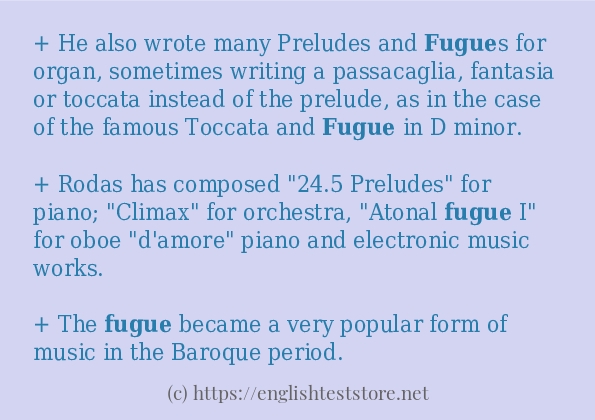How to use in-sentence of “fugue”:
+ He also wrote many Preludes and Fugues for organ, sometimes writing a passacaglia, fantasia or toccata instead of the prelude, as in the case of the famous Toccata and Fugue in D minor.
+ Rodas has composed “24.5 Preludes” for piano; “Climax” for orchestra, “Atonal fugue I” for oboe “d’amore” piano and electronic music works.
+ The fugue became a very popular form of music in the Baroque period.
+ There is a gentle hymn of praise with a fugue which sounds like one from Mozart’s Requiem.
+ These include: “Nativité”, “Six Études”, “Sept Méditations sur le Saint-Esprit”, “Triptyque”, “Twelve Choral-Preludes on Gregorian Chant Themes”, “Te Deum”, “Répons pour les Temps Liturgiques”, and “Prélude et fugue en UT”.
+ A fugue always starts with just one part playing the subject.

Example sentences of “fugue”:
+ However, it does appear as a secondary key area in several works in sharp keys, for example in the Prelude and Fugue in C sharp major from Bach’s Well-Tempered Klavier, Book 1.
+ Benjamin Britten writes a fugue at the end of A Young Person’s Guide to the Orchestra.
+ The Toccata and Fugue in D minor, BWV 565 is a work for Organ organ by Johann Sebastian Bach.
+ The last of these composers wrote “The Well-Tempered Clavier”, which has a prelude and fugue in every major and minor key.
+ Because a fugue is a piece which puts several lines of melody together it is a form of contrapuntal music.
+ Classical music can have many forms, including the symphony, concerto, oratorio, opera, sonata, fugue or any combination of dance movements such as suites.
+ Two months later, after he had gone home to Leipzig, Bach made up a six-voice fugue based on the king’s theme.
+ However, Johann Sebastian Bach actually chose C-sharp major for Prelude and Fugue No.
+ A fugue usually has three sections: the first section is called the “exposition”.
+ At the end of his song for choir called “The Twelve” William Walton starts a fugue with a very long, fast and complicated fugues subject, but it soon develops into a much freer piece of music.
+ A fugue is a piece of music written for a certain number of parts.
+ For example, there are several Preludes and Fugues in G major, but putting “Prelude and Fugue in G major BWV550″ makes it clear which one it is.
+ However, it does appear as a secondary key area in several works in sharp keys, for example in the Prelude and Fugue in C sharp major from Bach's Well-Tempered Klavier, Book 1.
+ Benjamin Britten writes a fugue at the end of A Young Person’s Guide to the Orchestra.
+ The Toccata and Fugue in D minor, BWV 565 is a work for Organ organ by Johann Sebastian Bach.
